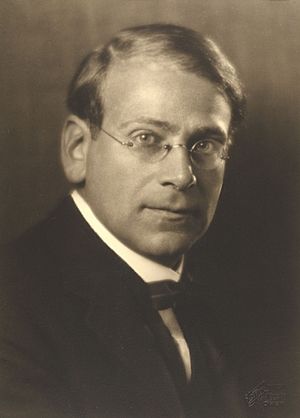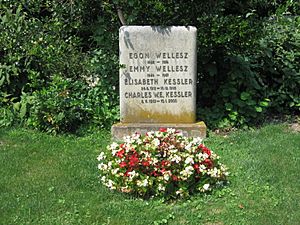Egon Wellesz facts for kids
Quick facts for kids
Egon Wellesz
|
|
|---|---|
 |
|
| Born |
Egon Joseph Wellesz
21 October 1885 Vienna
|
| Died | 9 November 1974 (aged 89) Oxford, England, UK
|
| Education |
|
| Organization | Lincoln College, Oxford |
Egon Joseph Wellesz (born October 21, 1885 – died November 9, 1974) was a famous composer, teacher, and music historian. He was born in Austria but later became British. He was especially known for his studies of Byzantine music, which is ancient Christian music from the Eastern Roman Empire.
Contents
Egon Wellesz's Early Life and Education
Egon Joseph Wellesz was born in Vienna, Austria, on October 21, 1885. His parents were from Hungary and had Jewish backgrounds, but they practiced Christianity in Vienna. Egon was raised as a Protestant and later became Catholic. As a boy, he went to a school where he learned about ancient Greek and Latin.
Egon's parents wanted him to work in his father's textile business or become a government worker. So, he started studying law at the University of Vienna. However, Egon really wanted to work in music. This dream began when he was 13. His parents gave him a special birthday present: tickets to see an opera called Der Freischütz. The famous conductor Gustav Mahler was leading the orchestra. Egon was so amazed by the opera that he decided he wanted to be a composer. Even before this, he had started learning piano from his mother's teacher, Carl Frühling.
In 1905, when he was 19, Egon began studying music with Arnold Schoenberg. He learned about harmony (how notes fit together) and counterpoint (how different melodies work together). He also attended a school run by Eugenie Schwarzwald, which was important for his music and social life. There, he met famous artists and writers like Rainer Maria Rilke and Oskar Kokoschka. He also met his future wife, Emmy Stross. His lessons with Schoenberg were very strict and taught him the basics of music. Later that year, he started studying musicology (the study of music history and theory) with Guido Adler at the University of Vienna. Both Schoenberg and Adler greatly influenced Egon's musical ideas and research.
Egon Wellesz's Work as a Scholar and Composer
Egon Wellesz first focused his music research on Baroque opera, which is a style of opera from the 1600s and 1700s. He wrote his university paper on a composer named Giuseppe Bonno. After graduating in 1908, he married Emmy Stross, and they had a long and happy marriage.
In 1913, Egon became a lecturer (a type of teacher) at the University of Vienna. That same year, he became very interested in the music of Byzantium, an ancient empire. This interest grew from talking with an art historian named Josef Strzygowski. Strzygowski believed that many early Christian buildings were inspired by designs from the East, not the West. Egon's wife, Emmy, was an art historian who also studied Eastern art, so these discussions were common. Egon wanted to compare how chant music developed in both the East and the West.
Also in 1913, one of Egon's own musical pieces was performed for the first time. It was his String Quartet No. 1, which showed the influence of Mahler and Schoenberg. Egon was the first student of Schoenberg to become a successful composer on his own. He signed a contract with a music publisher before other famous students like Alban Berg and Anton Webern. He wrote more string quartets that used new and different sounds. However, Egon became most famous for his dramatic music, like ballets and operas. He wrote many operas and ballets, often working with important writers like Hugo von Hofmannsthal. His operas often used stories from ancient myths.
In 1922, Egon helped start a group called the Internationale Gesellschaft für Neue Musik, which later became the International Society for Contemporary Music. This group helped promote new music. In 1929, Egon became a full professor at the University of Vienna. He stayed there until 1938, when he had to leave Austria because of the Anschluss, when Nazi Germany took control of Austria.
Egon Wellesz's Life in England
Luckily, Egon had connections in England, which helped him when he had to leave Austria in 1938. He was in Amsterdam when the Anschluss happened, hearing his orchestral piece Prosperos Beschwörungen performed. Once in England, he worked on a music dictionary. However, in 1940, he was held in a camp on the Isle of Man because he was from an enemy country during World War II. He was released later that year, thanks to help from famous musicians like Ralph Vaughan Williams.
After being held, Egon found it hard to compose music for a while. But he eventually started writing again, creating his String Quartet No. 5. He also found inspiration in the poems of Gerard Manley Hopkins, which led him to compose The Leaden and the Golden Echo.
Even though he composed, Egon Wellesz is also very well known as a music historian and teacher. His deep studies of Byzantine music and 17th-century opera earned him an honorary degree from Oxford University in 1932. He later became a fellow at Lincoln College, Oxford, where he taught many students until he died. He was also chosen as a Fellow of the British Academy in 1953, which is a great honor for scholars.
Egon continued composing until he had a stroke in 1972. He passed away two years later and was buried in Vienna. His wife, Emmy, returned to Vienna and lived there until she died in 1987.
Egon Wellesz's Music
Egon Wellesz wrote over 100 musical works. His large dramatic pieces, like his six operas, were mostly written when he lived in Vienna. One of his operas, Alkestis, is considered one of his most important stage works. It was performed successfully many times.
He also wrote nine symphonies (large pieces for orchestra) and nine string quartets (pieces for four string instruments). Some of his symphonies have special titles, like the Second Symphony, called The English, and the Fourth, called Austriaca. His music was generally well-liked in Austria, Germany, and England. He also wrote concertos for piano and violin, choral works like the Mass in F minor, and many vocal pieces with orchestra.
Egon's early music had a strong, but sometimes clashing, sound. Later, in the 1940s, his symphonies sometimes sounded similar to the composer Anton Bruckner, with a grand and wide feel, but still with a modern touch. After his Fourth Symphony, his music became less clearly tonal, meaning it didn't always stick to traditional scales. He even used serialism, a modern composing technique, but still kept hints of traditional melody.
Instead of following the very emotional style of his teacher Schoenberg, Wellesz looked to older music for inspiration. He became a leader in moving away from the Romantic style of music that was popular before his time. He believed that music should return to clear, well-defined forms, like those found in Baroque opera.
Recordings of Egon Wellesz's Music
You can find recordings of many of Egon Wellesz's works. There's a complete set of his nine symphonies performed by the Radio Symphonieorchester Wien. You can also find recordings of some of his string quartets, choral works, and concertos.
- Chamber Music: Clarinet Quintet, Op. 81, String Trio, Op. 86, Four Pieces for String Quartet, Op. 103, and Four Pieces for String Trio, Op. 105. Veles Ensemble, Toccata TOCC0617 (2023)
- Choral Music and Song: Mass in F, Op 61; Missa Brevis, Op 89, To Sleep Op 94. Choir of Christ Church Cathedral, Oxford. Nimbus NI5852 (2011)
- Piano Concerto: with Triptychon, Op 98; Divertimento, Op. 107; Drei Skizzen, Op. 6; Eklogen, Op. 11. Karl-Andreas Kolly (piano), Luzerner Sinfonieorchester/ Howard Griffiths, Pan Classics 510104 (1999)
- String Quartets: No. 3, 4 and 6. Artis Quartett Wien. NIMBUS NI 5821 (2008)
- Symphonies No 1 – 9 (4-CD Set). Radio Symphonieorchester Wien/Gottfried Rabl, CPO 777183-2 (2009)
- '20th Century Portraits': The Dawn of Spring; Sonnets from the Portuguese Op. 52; Song of the World, Op. 54; Life, dream and death Op. 55; Ode to Music, Op. 92; Vision, Op. 99; Symphonic Epilogue, Op. 108. Deutsches Symphonie-Orchester Berlin/Roger Epple, Capriccio 67 077 (2004)
- Violin Concerto: with Prosperos Beschwörungen, Op. 53. Andrea Duka Lowenstein (violin), Radio Symphonie Orchester Wien/Gerd Albrecht, ORFEO C 478 981 (1999)
Awards and Honors
Egon Wellesz received many awards for his contributions to music:
- 1953: City of Vienna Prize for Music
- 1957: Commander of the Order of the British Empire (CBE)
- 1957: Great Silver Medal of the City of Paris
- 1959: Grand Decoration of Honour in Gold for Services to the Republic of Austria
- 1961: Grand Austrian State Prize for Music
- 1961: Order of St. Gregory the Great (from the Vatican)
- 1971: Foreign Member of the Serbian Academy of Sciences and Arts
- 1971: Austrian Decoration for Science and Art
- 1973: Honorary Member of the Society of Friends of Music in Vienna
Images for kids
See also
 In Spanish: Egon Wellesz para niños
In Spanish: Egon Wellesz para niños




